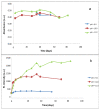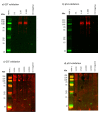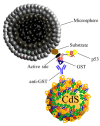Detection of Human p53 In-Vitro Expressed in a Transcription-Translation Cell-Free System by a Novel Conjugate Based on Cadmium Sulphide Nanoparticles
- PMID: 32455562
- PMCID: PMC7279493
- DOI: 10.3390/nano10050984
Detection of Human p53 In-Vitro Expressed in a Transcription-Translation Cell-Free System by a Novel Conjugate Based on Cadmium Sulphide Nanoparticles
Abstract
Here, cadmium sulphide quantum dots (CdS QDs) have been synthetized and functionalized with Bovine Serum Albumin (BSA) in a colloidal aqueous solution with a stability of over 3 months. Specific synthesis conditions, in homogeneous phase and at low temperature, have allowed limitation of S2- concentration, hence, as a consequence, there is restricted growth of the nanoparticles (NPs). This fact allows binding with BSA in the most favorable manner for the biomolecule. The presence of Cd2+ ions on the surface of the CdS nanoparticle is counteracted by the negatively charged domains of the BSA, resulting in the formation of small NPs, with little tendency for aggregation. Temperature and pH have great influence on the fluorescence characteristics of the synthetized nanoparticles. Working at low temperatures (4 °C) and pH 10-11 have proven the best result as shown by hydrolysis kinetic control of the thioacetamide precursor of S2- ion. Biological activity of the coupled BSA is maintained allowing subsequent bioconjugation with other biomolecules such as antibodies. The chemical conjugation with anti-Glutathione S-transferase (α-GST) antibody, a common tag employed in human recombinant fusion proteins, produces a strong quenching of fluorescence that proves the possibilities of its use in biological labelling. Finally, p53, onco-human recombinant protein (GST tagged in COOH terminus), has been in situ IVTT (in vitro transcription-translation) expressed and efficiently captured by the α-GST-CdS QD conjugate as a proof of the biocompatibility on IVTT systems and the functionality of conjugated antibody.
Keywords: CdS-BSA quantum dots; IVTT protein expression; bovine serum albumin; fluorescent immunoassays; nanoparticles; protein detection; synthesis.
Conflict of interest statement
The authors declare no conflict of interest.
Figures












References
-
- Kango S., Kalia S., Celli A., Njuguna J., Habibi Y., Kumar R. Surface modification of inorganic nanoparticles for development of organic–inorganic nanocomposites—A review. Prog. Polym. Sci. 2013;38:1232–1261. doi: 10.1016/j.progpolymsci.2013.02.003. - DOI
LinkOut - more resources
Full Text Sources
Research Materials
Miscellaneous

